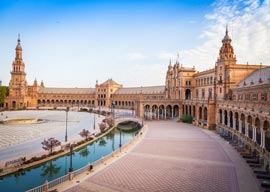
October 10, 2015

Seville, Spain
Source: Shutterstock
Seville—Let’s take it from the top: Seville is one of the most beautiful cities in Europe, the capital of Andalusia, situated by the banks of the Guadalquivir River, with a history that predates Greeks and Phoenicians. (Almost as old as Milton Keynes, but slightly more exciting at night.) The place reeks of charm and old-world splendor, its palaces, cathedrals, forts, and magnificent spaces reflecting a civilization that worshipped a Christian god and an all-conquering Christian army. The Cathedral of Seville is the biggest temple in Spain and a third of the Christian world, exceeded only by the Basilica of Saint Peter in Rome and Saint Paul’s in London. And it was built on top of the great mosque while conserving la Giralda, the minaret it replaced once the Moors were chased out. This was back in 1248, and it illustrates why we’re on a losing streak. When the Muslims negotiated the surrender of Seville to the Christian forces, they asked that the great mosque and its minaret be destroyed in order not to be soiled by people like you and me. But Don Alfonso, the winner, threatened to kill anybody who dared destroy the beautiful edifice. Exactly like those nice guys of the Islamic State in Palmyra, n’est-ce pas?
Going around the city of 800,000 is a revelation in civilized living. One hears hardly a sound of traffic, there is no strewn garbage, and most of the tourists flocking the fortresses and palaces are Spanish. Yes, there are Chinese, but outnumbered by the locals. South Saharans are few, and I counted only about 15 women wearing towels on their heads. The city has very wide, imperial boulevards, beautiful parks and gardens, and narrow streets that evoke mystery, romance, bullfighting, and flamenco.
This is Papa Hemingway and Ava Gardner country, baroque-style facades and the oldest bullring in the world. Built in 1761, the place reeks of blood and sand and tragedy. Leopold Bismarck, Tim Hoare, and I visited it briefly. Tim had trouble walking because of a bad knee, and I explained to the patient Spaniards shuffling slowly behind him that he was the greatest English matador and recently injured in the ring. They nodded politely but slightly amazed. Tim is not built like Manolete, nor does he have the late, greatest-ever matador’s sad countenance.
Although I’m not an expert in tauromachy, the five greatest bullfighters ever are Belmonte, Joselito, Manolete, Dominguin, and Ordóñez, and if anyone disagrees they can go to the sports palace in Amsterdam and wait for me to settle the score. The greatest opening line of any book is that of Barnaby Conrad in The Death of Manolete: “On August 28,1947, in Linares, Spain, a multimillionaire and a bull killed each other, and plunged a nation into mourning.” It beats Jane Austen’s “a truth universally acknowledged” and it leaves “Call me Ishmael” in the dust. And it makes “the best of times and the worst of times” seem second-rate. Bravo, Barnaby, a friend of mine and author of Gates of Fear, the bible of bullfighting.
The previous afternoon I had gone with my friend John Rigas to the Plaza de España, a semicircle of 200 meters with two high towers on each end of the edifice, and explained to some know-nothing tourists that the butler to the then King Alfonso became one of the world’s greatest marathon runners as he had to sprint back and forth 200 meters at least 40 times per day while serving his master. Some of them believed me.
The reason for my visit was a delight in itself: The Prince Augusto Ruffo di Calabria’s 60th birthday. Augusto has too many titles to list in these here pages, so I will mention only that he’s also the president of the Corviglia Club in St. Moritz, where I first met him. He’s married to an Austrian princess and has three beautiful children. His family has as much in common with the Hiltons and Kardashians as a popinjay does with a male lion. I spent three delightful days and nights with them, culminating with a grand dinner dance at the Casa de Pilatos, probably the grandest private palace in Seville, where 190 of us sat in a square courtyard filled with candles and flowers under white marble mosaics. Something tells me that I’ve been in more beautiful settings, but it also tells me that it was in a previous life. I sat next to Debonnaire Bismarck and watched the birthday boy’s brother-in-law Heinrich Fürstenberg do a torrid paso doble, and listened while Nick Scott spoke beautiful Andalusian Spanish to the servers, who understood not a word. It was a wonderful three days in a beautiful city, given by an Italian prince of the old school. The only sad note is that parties like this are bound to go with the wind sooner rather than later. The aforementioned scum like the Kardashians are the future, and that’s not good news for the poor little Greek boy. Soon I’m off to where all that bad stuff comes from, New York, but only for the first major show devoted to my hero, Papa Hemingway, which opened at the Morgan Library last week. It might not be Seville, but it’s the next best thing.